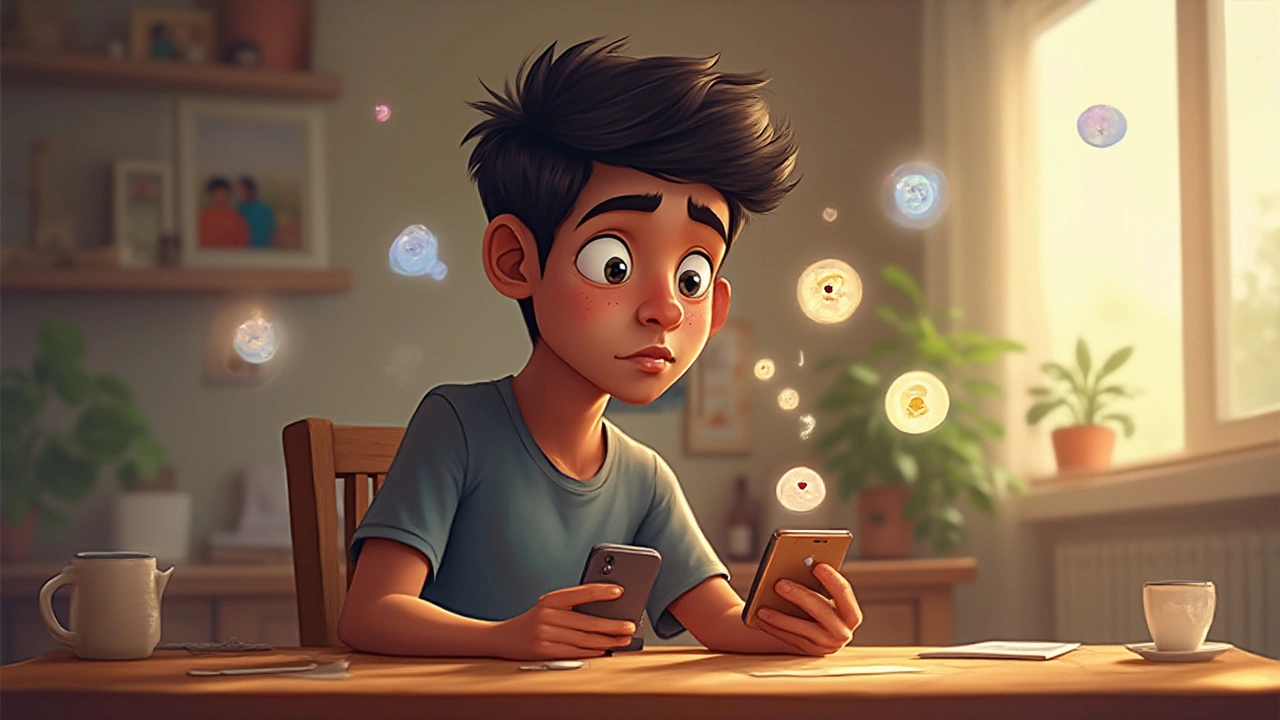
Picture this: you’ve got years’ worth of photos, a web of iMessages to your mates, and a phone packed with the little digital stuff that makes it distinctly yours. Now, you’re sick of squinting at Apple’s high prices or fancy trying a Samsung or Pixel phone just to see what all the fuss is about. Will you lose everything if you switch from iPhone to Android? Or is that just a scary story passed around Apple Store queues?
The panic isn’t random. Apple builds its tech to keep you in its world, and a lot of people worry about their data vanishing if they jump ship. But the truth is, while some things might be lost or change a bit, you don’t have to say goodbye to your memories, contacts, or even your playlists. It’s not about what you’ll lose, but about what you’ll keep—and how to make it as painless as possible.
What You Actually Lose (And What You Don’t) When You Switch
Switching from iPhone to Android is nowhere near as ruthless as it was a decade ago. But it’s not as seamless as changing brands of pasta, either. If you’re signed heavily into Apple—iCloud photos, iMessages, Apple Notes, and so on—then some features just don’t follow you to Android, while others do, with a few workarounds.
Let’s talk about your photos and videos. Most iPhone owners use iCloud Photos, which keeps everything in the cloud, but Android doesn’t talk to iCloud natively. However, there’s an app for this—Google Photos for iOS. Just download Google Photos on your iPhone and let it back up everything (over Wi-Fi, so you’re not destroying your mobile data). Once you get your Android up and running, log into Google Photos, and all your snaps from your iPhone will be right there. It’s surprisingly easy and free if you stay under 15GB or just pay for extra storage if you’re a serial photographer like my youngest, Soren, with his endless pics of our dog snoozing.
What about contacts? If your contacts are stored in your iCloud by default, you’ll need to export them first. It’s easy with iCloud.com—just pick all, then export as a vCard. Send it to your Google account, and your Android will sync them instantly. If you keep them in Gmail already, you’re sorted; just sign in on your Android.
Your messages, though? Here’s where things get sticky. iMessage is an Apple walled garden. There are some third-party tools—like "iSMS2droid" or "MobileTrans"—that try to bridge the gap, but don’t count on seamless transfers. WhatsApp’s easier. Their official tool moves chats from iPhone to Android for most major Android brands, especially Samsung and Google Pixel devices. If you live in WhatsApp like I do with school groups for Annelise, you won’t lose your chats.
Apps themselves are a mixed bag. Most of your staple apps—Instagram, Gmail, TikTok, Spotify, etc.—are cross-platform. Your in-app stuff, like progress in a game or notes in a journaling app, might or might not move over. Check the app before you switch. Some like Evernote or Google Keep live in the cloud. Many games are tied to Game Center on iOS but use Google Play Games on Android, and there’s rarely a bridge. Think of it like changing loyalty cards—you might have to start over in some places.
App purchases—gone. If you’ve bought apps on iOS, they don’t transfer. You buy Android versions fresh. It’s a pain if you’ve dropped a tenner on a premium calendar app, but only software makers benefit from this rivalry. Fortunately, most of us use free apps anyway.
Apple-only services like Apple Notes, Keychain passwords, Apple Mail rules, and Apple Music downloads don’t come over easily. You can manually export notes (slow but doable) or switch your password vault to a cross-platform app like 1Password. For music, you can use apps like SongShift to transfer playlists from Apple Music to Spotify or YouTube Music.
FaceTime, iMessage, and AirDrop? No native versions on Android, though FaceTime links for web calls do work now thanks to iOS 15’s update. But they aren’t as smooth, and you’ll probably just use WhatsApp, Signal, or Zoom instead.
Let’s add some hard numbers. According to a 2024 report from Counterpoint Research, about 17% of people who switched from iPhone to Android cited "data loss anxiety" as the main reason they hesitated. But only 6% of those who switched ended up missing important photos or contacts—a lot less dramatic than the headline warnings suggest.

How to Make the Switch Without Losing Your Stuff
All right, time to get hands-on. The good news? There’s no need to be a tech wizard to make the jump. The process is more about patience and organisation than technical skill.
1. Back Up Everything First. First rule of any tech change: back up. Use iCloud and (just to be sure) iTunes or Finder to back up your iPhone locally. If disaster strikes, you can restore your iPhone to where you started.
2. Loads of Photos or Videos? Download Google Photos and give it time to sync all your memories. You’ll see a little checkmark when it’s done. If you want to transfer a massive video collection, connect your iPhone to a computer and copy them directly.
3. Switching Contacts: Go to iCloud.com, export contacts as vCard, and import them into Google Contacts on a PC or Mac. Sign in on your Android, and you’re good.
4. Moving Your Messages: If WhatsApp is your main messaging app, there’s a built-in iOS-to-Android transfer tool. Open WhatsApp, go to Settings > Chats > Move Chats to Android. For SMS and iMessage, you’ll need a tool like "Move to Android" or even a Samsung Smart Switch if you’re joining Team Galaxy.
5. Music, Notes, Files, and More: For music, use SongShift or FreeYourMusic to port playlists to Spotify, YouTube Music, or Amazon Music. For Apple Notes, open each note, copy-paste to Google Keep or another app. Not quick, but you’ll thank yourself later.
6. Signing Out and iMessage: Before popping your SIM out, deregister iMessage at apple.com/deregister-imessage. If you skip this, your texts could disappear into Apple’s ether, confusing your mates for weeks. Trust me, it’s annoying.
Manufacturers are stepping up with tools. Google’s "Switch to Android" app guides you through every step, from copying photos to disabling iMessage. Samsung’s "Smart Switch" is hands-down the gold standard—it can even pull certain app data and messages that other tools miss if you plug both devices together.
Even after all this, expect to fiddle with things for a week or two. You’ll have to re-login to banks, social media, streaming, and maybe lose a few inside jokes buried in rusting iMessage threads. And your muscle memory—swiping up instead of back, or missing the iOS control centre—takes a while to rewire.
Here’s a little breakdown to keep things clear:
| Data Type | Moves Over Easily? | How |
|---|---|---|
| Photos & Videos | Yes (with Google Photos) | Google Photos backup |
| Contacts | Yes | Export iCloud, import to Google |
| Yes | WhatsApp built-in tool | |
| iMessages | No | 3rd party tools, not always reliable |
| Apple Notes | Partial | Manual export |
| App Data | Sometimes | Depends on the app |
| Paid Apps | No | Buy again |
| Music Playlists | Usually | SongShift, FreeYourMusic |
Give yourself a weekend to do the move—maybe the same weekend you’re waiting in for a dishwasher repair or escaping Brighton’s drizzle. Don’t leave it for a lunch break unless you want a headache.

Android Surprises, Family Tech Drama, and the Good Stuff
Now, once you’re in the Android world, it doesn’t feel as alien as people say. Customisation is the big win; that, and the wild choice of phones. Whether you pick something like a flashy Galaxy S24 Ultra or a Google Pixel 9, you’re now in charge—no more Apple lock-in. Widgets, themes, even completely different launchers; Soren spent hours making his home screen look like the Millennium Falcon’s dashboard.
You might miss certain Apple flourishes, but you gain others. Google’s "Call Screen" blocks spam calls like a bouncer outside a dodgy Brighton club, and Google Assistant understands natural questions better than Siri. File management is much freer—hook your phone up to a laptop and drag files in and out with no fuss.
Privacy settings? Android’s caught up; you can now block specific app permissions, review what’s being shared, and even put a "temporary lockdown" on location access. That said, you do trade away the deep, baked-in privacy Apple leans on for marketing. If you’re moving kids over too, Android's Family Link app lets you wrangle screentime, purchases, and app usage almost as easily as Apple’s Screen Time. We've had fewer random app installs and family friction since moving Annelise’s phone onto Family Link—it spells out exactly what’s happening account by account.
Battery management is less mysterious on Android. You get proper data—a chart showing every app’s drain hour by hour. And when it’s time to supercharge, most Androids support proper fast-charging, not Apple’s more laid-back speeds. That means less time chained to a power outlet during late-night gaming or during those epic, two-hour school events where your battery seems determined to die.
But let’s not pretend everything is perfect. Some apps work slightly differently; Google Messages is reliable but won’t replace the feel of iMessage with its blue-bubble in-jokes. Some YouTube links automatically open in browser instead of the app, and not every Android is made equal—bargain phones get slow updates. Still, Android fans are a resourceful bunch, and after a short learning curve, most people say they're happier with the control, flexibility, and sometimes, the lower prices. (A bit extra money in my pocket means another skate trip with the kids or a less guilty pint with mates.)
If you’re worried about your ‘digital life’ being shattered by switching, you’ll find that 90% of it comes across just fine. There's nostalgia in those old iMessage threads, but you get to start fresh with better customisation, powerful features, and a new chance to find out what you really want from your phone.